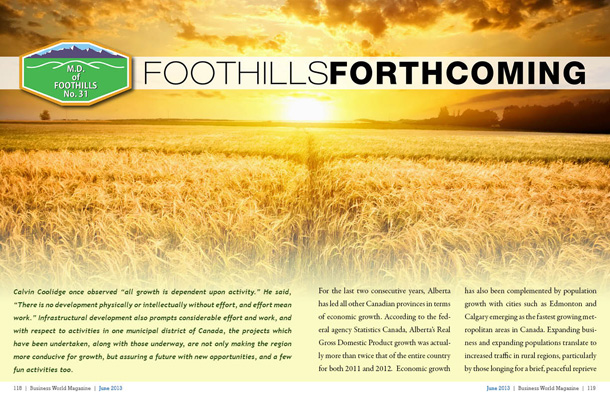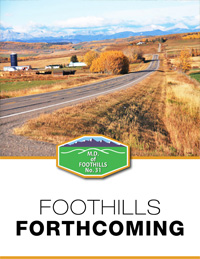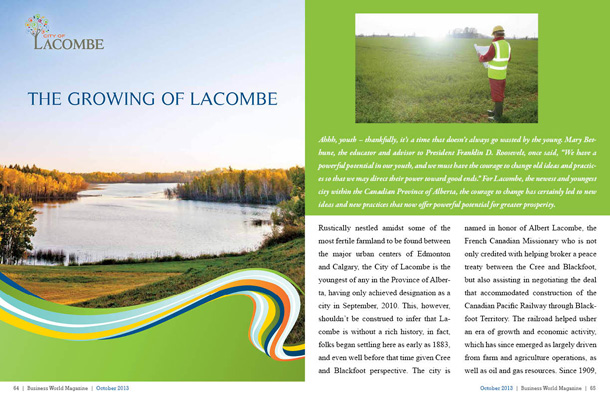
Foothills Forthcoming
Calvin Coolidge once observed “all growth is dependent upon activity.†He said, “There is no development physically or intellectually without effort, and effort means work.†Infrastructural development also prompts considerable effort and work, and with respect to activities in one municipal district of Canada, the projects which have been undertaken, along with those underway, are not only making the region more conducive for growth, but assuring a future with new opportunities, and a few fun activities too.
For the last two consecutive years, Alberta has led all other Canadian provinces in terms of economic growth. According to the federal agency Statistics Canada, Alberta’s Real Gross Domestic Product growth was actually more than twice that of the entire country for both 2011 and 2012. Economic growth has also been complemented by population growth with cities such as Edmonton and Calgary emerging as the fastest growing metropolitan areas in Canada. Expanding business and expanding populations translate to increased traffic in rural regions, particularly by those longing for a brief, peaceful reprieve from the realities posed by urban density. In fact, some may even wish to revel in the rural, rustic charm connoting to country life in Canada, for a long-term duration. Though such rural areas might not evoke the kind of name recognition as their big city neighbors, rest assured that these spaces are indeed comprised by residents and municipal forces doing all within their power to serve, protect and prosper in the advancing of infrastructure and the development of projects that not only impart a quality of life, but respond to the needs and demands unique to their region. Such is the case with an area known as Municipal District Foothills #31.
One of the fastest growing municipalities in Alberta, the district is located adjacent, but immediately south of Calgary. Comprising a terrain of more than 3,600 square-kilometers, the MD encompasses towns and villages such as Black Diamond, High River, Long View, Okotoks and Turner Valley, the Indian Reserve at Eden Valley, as well as a number of small hamlets which include destinations known as Blackie, Cayley, Heritage Point and Millarville, to name but a few. Collectively, the district has a population that is a little more than 20,000 people and there are more than 2,000 kilometers of road connecting all from point to point and beyond.
A Revolution in Roadways
Seneca once said it’s a rough road that leads to the heights of greatness, and to be sure, this district is being served by some of the greatest, most dedicated, innovative and capable of road crews who confront challenges from meteorological fronts to factors of terra firma atypical of conditions anywhere else in the world. And while their toiling may have once been exacted on that indicative of the road less traveled, the fact remains that district roadways are seeing increased traffic. At present, 40% of roadways are paved and the remaining 60% is gravel. Either surface comes with unique challenges in terms of care and maintenance.
Hugh Pettigrew is Deputy Director of Public Works & Engineering and part of the team tasked with ensuring that the roads and bridges are not simply traversable, but especially safe for all who pass. A little more than 45% of the district’s entire budget is allotted to services provided by Public Works and Pettigrew says “the trick is to do everything we need to do, but not go broke as we do it.â€
“There’s more priorities than what we have money for, and everybody has aging infrastructure which has to be maintained or upgraded. Our role, like that of any municipality, is to provide good governance and provide for our residents,†says Pettigrew.
Good governance, he adds, comes with imparting a certain practicality in the stewardship of resources and intensive analysis of priorities. With grant funding diminishing even as traffic has been increasing, Pettigrew’s team has been particularly resourceful, even garnering acclaim, for their innovative approach to road maintenance. For example, the district’s Maintainable Road Oil Program has proven highly successful at enhancing roads originally slated for more costly re-paving. Using chip-seal patching or applying thickness to targeted areas, public works has been able to extend the life of roads through resurfacing at a cost of approximately $25,000 a kilometer, which is significantly less than what it costs in any other area of the country. In fact, the district has prompted attention from other districts wanting to know exactly how they accomplish that.
There have been a number of other developments. For example, the district recently completed some $37 million worth of construction creating an interchange north of the community of High River which now directly links Highway 2 with the highly-traversed industrial corridor of Highway 2A. In addition to improving access for emergency vehicles and commuters alike, the interchange accommodates heavy trucks serving operations like Cargil, one of the world’s largest suppliers of food products. Area residents equally benefit from not seeing so many cattle trucks having to drive through their town.
Safe environmental practices have been another priority for the public works department. For an area subject to extreme winter conditions, the department has traditional deployed salt to help melt ice and snow. Pettigrew says in accordance with new environmental regulations involving run-off, the department has decreased the salinity of the mix used for melting and has found ways to apply it less liberally by targeting particular slopes and curves. As Pettigrew says, winters can pose genuine challenge as Chinooks (warm winds) come over the hills to melt the ice on roads, which then refreeze, prompting effort to maintain the safety and integrity of area roadways. “Our road crews are some of the most dedicated people you will ever meet, and many will wake-up in the middle of the night, and go to work making sure the roads are safe,†says Pettigrew.
While public works is responsible for a portion of the district roadways, a significant number of other roads fall under the care of Alberta’s Department of Transportation. In recent years, funding from grants has been crucial to paying for the care of district roads and bridges, but some of those resources have now dissipated as provincial budgets have diminished. Pettigrew says that has prompted careful examination of priorities in terms of which roads and bridges need immediate attention versus those that can wait. He says safety will not be compromised in the process and he expresses confidence that new grants or financing strategies stemming from public and private partnerships will emerge to further assist with costs.
Paving, graveling, chip sealing, dust controlling, snow plowing, ice melting – it all just represent a fraction of the daily work conducted by public works to ensure life continues to safely and efficiently flow through the district.
Water Supply
It’s also important that water flows. Pettigrew says creative minds have been at work from development and engineering to determine strategies for increasing access to potable water which has long been a focal point of concern in the district. Recently, the Towns of Turner Valley and Black Diamond, along with the Village of Longview, established a partnership with MD of Foothills to implement the Quad Regional Water Project (QRWP). The QRWP developed a strategy to create a sustainable regional water supply for the region which involves connecting the wells in Black Diamond to a water treatment plant in Turner Valley. In turn, the Turner Valley water treatment plant will be upgraded to include a pumping system and pipeline which will bring the treated water to Black Diamond. QRWP has been successful in applying for provincial funding through the Regional Collaboration Program and the Alberta Water/Wastewater Partnership Program. This funding is contributing 79% of the infrastructure costs for stage one. Benefits of the regional system will be reflected not only through reduced operating costs and energy usage, but also through the providing of a safe, secure and affordable water supply. The partnership will also serve to develop plans for addressing issues such as watershed stewardship, drought management, water conservation and water demand management. Pettigrew says that with the creation of such collaborative partnerships, the future looks promising. Whether in terms of addressing needs relating to roads and bridges, or needs involving water supply, he says, “We are very fluid in moving forward.â€
More to Come
Area roads will soon lead to new venues that are prompting particular excitement for area residents, especially hockey fans (that means almost everyone in Canada). The MD recently partnered with the town of Okotoks to develop the Regional Indoor Field House. Budgeted at $20 million, the facility is being paid through provincial grant funding from the Municipal Sustainability Initiative. MD Foothills Director of Community Services Ryan Payne says the field house will accommodate everything from indoor soccer and lacrosse to the staging of community events. The site will include four playfields, multi-surfaced spaces allowing for tennis, volleyball and badminton, as well as a number of multi-purpose rooms for classes, workshops or general meeting space. Payne says residents would typically have to travel to Calgary to find a similar caliber building, and he expects the field house to become an important hub of community activity.
An arena will also open later this year in Heritage Heights. The Scott Seaman Sports Rink will include an NHL-size ice rink, exercise rooms, a walking track as well as multi-purpose rooms that will provide another significant venue for staging community events. Payne says both sites have been developed to accommodate future growth.
The MD has also recently purchased 30 acres near the community of Millarville where Payne says concept planning is underway as to how best develop the site. Current discussion have involved creating another sports field near an existing equestrian center and camp ground. The MD is discussing proposals with the very active agricultural society who stages farmer markets, an annual marathon and other events in this area. Payne anticipates this will become yet another important hub of community gathering and events.
And while the field house and ice arena will effectively respond to current demands for kid-friendly sports and recreation, Payne says these developments will likely prompt even more growth in the district, both in terms of business and people.
Beyond sports and recreation, Payne’s department is also tasked with family, airport, police and fire services. He says as the MD continues to grow, and as urban counterparts grow, it will continue to drive demand for more services. That demand has recently led to the development of a new fire hall in Heritage Point. These services were formerly provided by volunteers, but now will be fulfilled by a dedicated team of professionally-trained firefighters and paramedics.
These professionals are now complementing a community which is continuing to compel important opportunities for a variety of other professionals. The advancing of infrastructure has led to jobs and meaningful work for a number of companies which include firms such as Scott Builders, Grant Construct and Hearst Construction, principal firms who have each played critical respective roles in the development of roads or the sport venues.
As the leaders of the MD continue to focus on the delivery of good governance through the enhancing of area infrastructure, from roadways and water resources to partnerships that expand and improve on services which enable a greater quality of life, look to this area of the Foothills to secure a firmer footing for future growth and prosperity.
For more information, please visit their website at: Â M.D. Foothills No. 31
Preferred Vendors of Choice:









